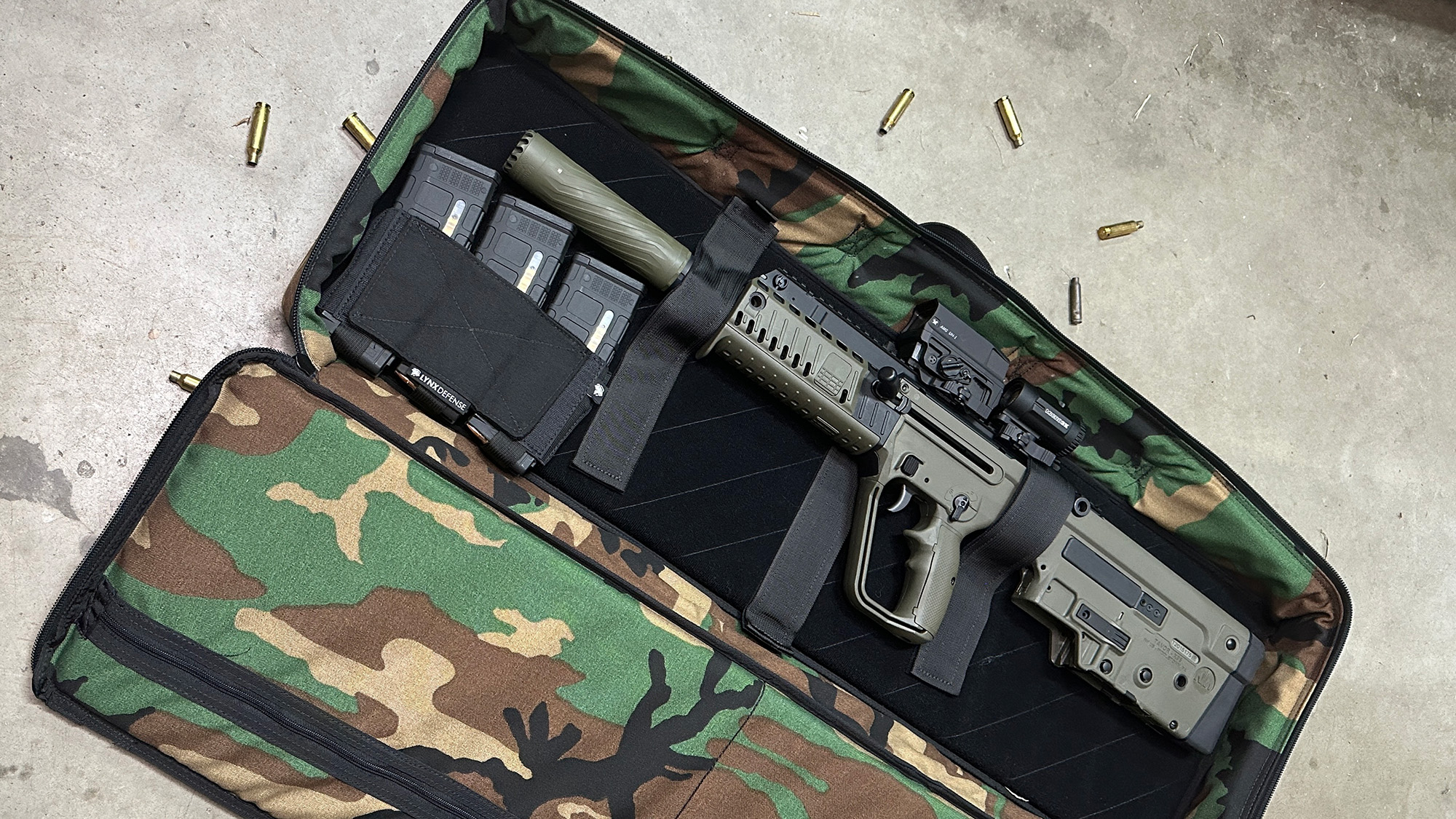
Ready to see what we have coming?
Lynx Defense will release some new things soon. Let us deliver them right to your inbox!

Lynx Defense will release some new things soon. Let us deliver them right to your inbox!
We may earn revenue from product links on this page and participate in affiliate programs. Learn More ›
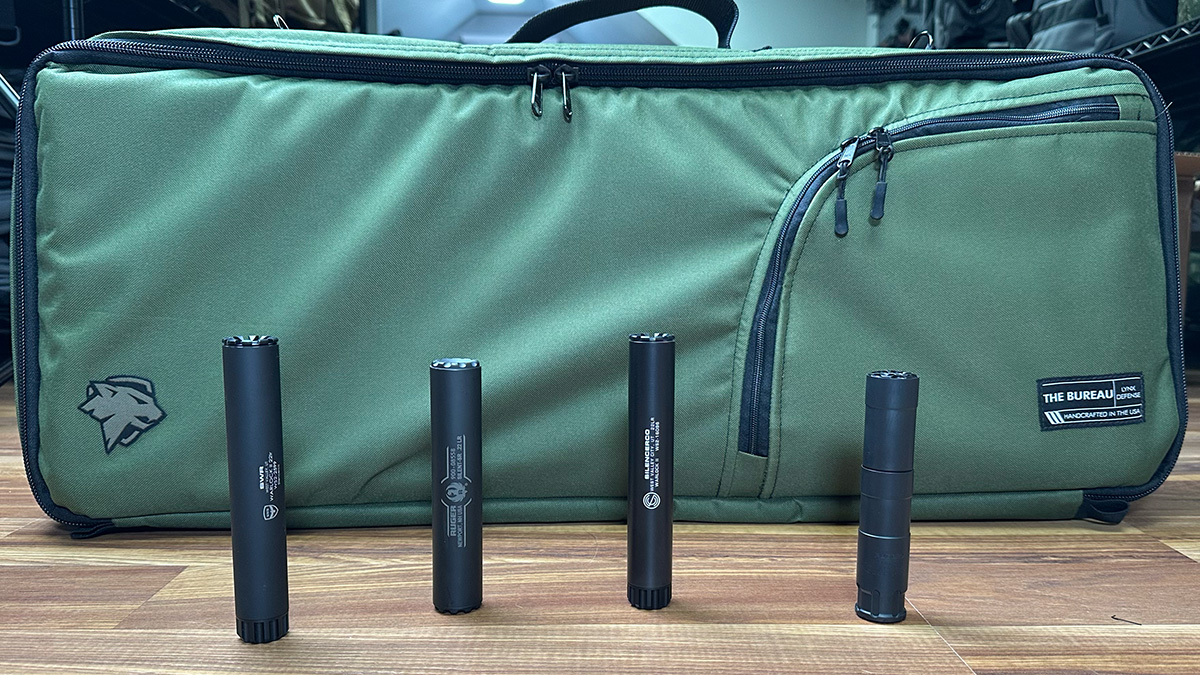
The .22 Long Rifle cartridge, first introduced in the late 19th century, remains one of the most popular and versatile rounds used by gun owners, especially when looking for a quiet, suppressed gun.
I’m a big fan of the 22LR round and finding the best 22LR suppressors has always been a goal.
Reducing the noise of the gunshot to ensure safe hearing is the most important thing about a 22LR suppressor.
Bestowed with the moniker of being the “gateway drug into the world of suppressors,” these relatively small contraptions can significantly diminish the noise generated from shooting your firearm, leading to a more pleasing and focus-intensive shooting experience.
Here is our list of the top five best 22LR suppressors on the market today.
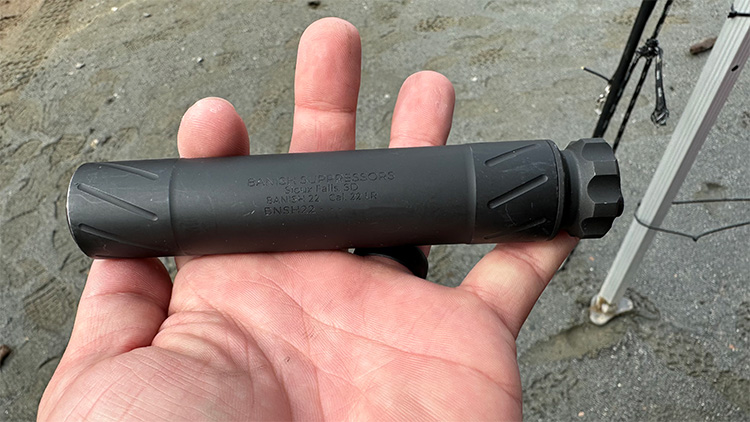
The Banish 22 suppressor is a highly effective and versatile silencer.
It is known for its exceptional noise reduction, reducing gunshot sounds to a minimum.
The suppressor is compatible with a wide range of .22 caliber firearms and comes apart extremely easily to clean the baffles.
It is constructed using durable and lightweight materials. The design allows for easy disassembly and cleaning.
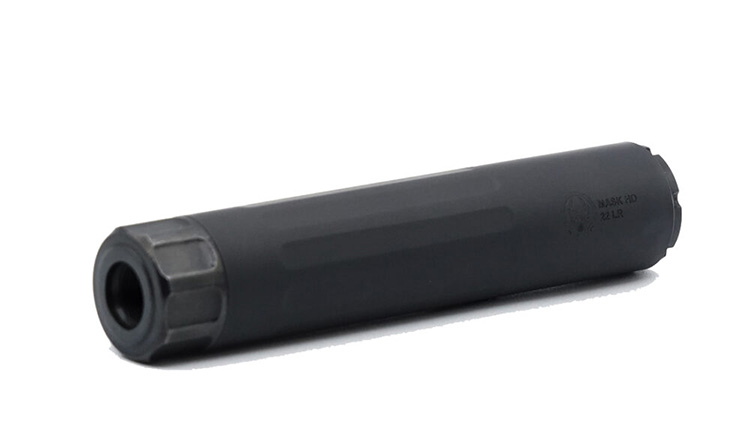
The Dead Air Mask is a top-tier 22LR suppressor and has been around the block for a while.
It effectively minimizes gunshot sounds, providing quieter shooting.
The Dead Air Mask is compatible with various .22 caliber firearms that accept a 1/2×28 thread pitch.
The Mask offers easy disassembly and cleaning for added convenience.
It would be a disservice to the world of 22LR suppressors not to include the Dead Air Mask in this list.
Crafted from sturdy 17-4 stainless steel, the Dead Air Mask prides itself on its robust construction. A stand-out feature is its innovative baffle design.
The baffles are constructed in a way that allows each to click together and seal tightly against each other.
This keeps the inside of the tube clean. Unique standoffs on the exterior of the baffles facilitate their smooth slide in and out of the tube regardless of suppressor dirt levels.
The Mask can also withstand the popular 5.7x28mm caliber (one of my favorites).
It’s even rated for fully automatic fire on a .22 LR and is safe to clean with brushes or ultrasonic tanks.
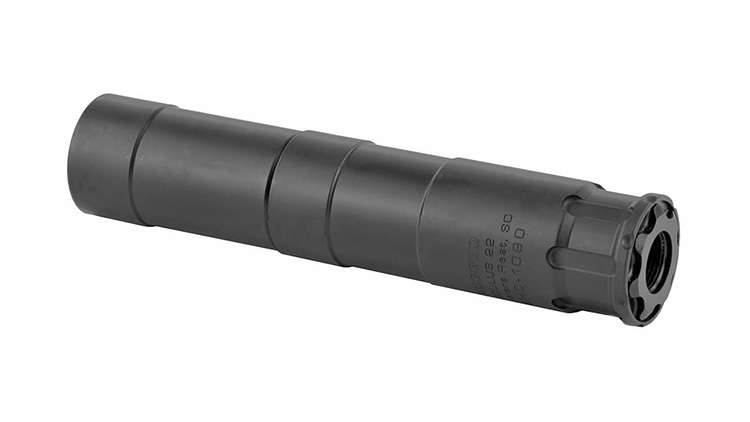
Rugged Suppressors are relatively close to us; thus, they are extra cool. Jokes aside, Rugged makes an outstanding, durable product.
I picked up my Rugged Oculus specifically to shoot 5.7x28mm on my FN PS90 and haven’t used it much for 22LR.
This suppressor is extraordinarily user-friendly and user-serviceable, which adds to its appeal.
This design efficiently eradicates the ‘first-round pop,’ succeeding at muting the loud sound that usually comes with the first shot.
The Oculus is frequently praised for this absence of first-round pop as ‘Hollywood quiet,’ truly gratifying.
I have had first-hand experience with Rugged support because I was a goof and didn’t tighten down the Oculus enough on the Smith & Wesson 5.7 pistol when shooting it.
One of my rounds struck my front-end cap, and when I reached out to Rugged, they sent me a new front cap, no questions asked.
They were fast, quick, and easy to support their product!
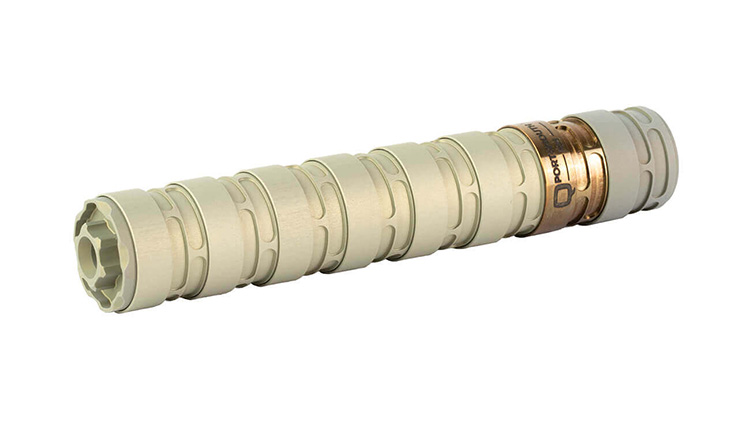
The somewhat new company “Q” has its line of suppressors and unique guns, such as the Honey Badger.
The Erector 22 is a unique-looking baffle suppressor that allows you to customize it to the size and noise reduction you want.
It comes with a small tool that you can use to tighten and loosen the baffle stacks and is really a cool suppressor.
This suppressor comes in black and clear anodizing, so you can choose your aesthetic.
The noise reduction on the erector is also very good and it is one other lightest 22LR cans I’ve ever used.
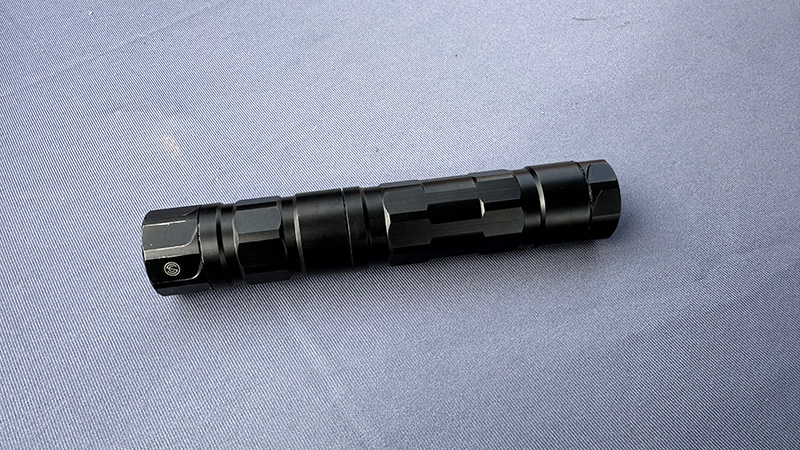
The Switchback 22 is a top-notch product distinguished as one of the most versatile rimfire suppressors on the market.
The key advantage of the Switchback lies in its modularity.
This suppressor can be assembled in three lengths, allowing you to customize its size based on the specific gun and application.
The Switchback is nothing short of versatile regarding compatibility: it can accommodate .22 LR, .22 WMR, .22 Hornet, .17 HMR, .17 WSM, and 5.7x28mm.
The Switchback is constructed from titanium and stainless steel and offers durability.
With its Click Together Assembly (CTA) design, the Switchback ensures that you’ll never put the baffles back incorrectly, delivering consistently high performance every time.
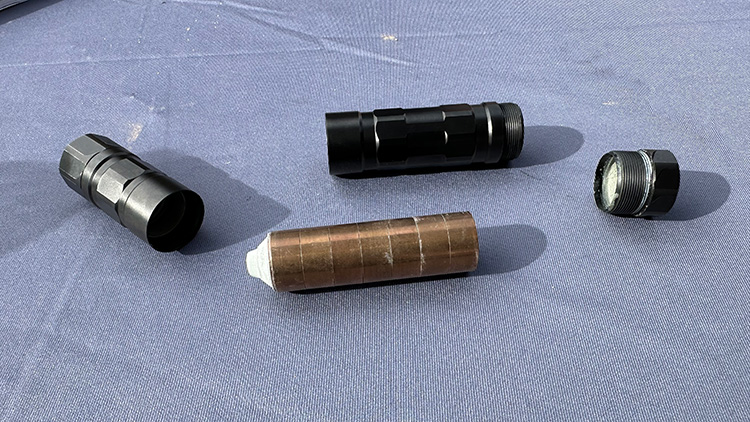
The Switchback makes maintenance easy. The suppressor comes apart for thorough cleaning and reassembles with relative ease.
Recently, I have added, by far, the best Ruger 10/22 suppressor to my gun.
The Angstadt Vanquish 22 suppressor (a full barrel replacement) is by far the best 22LR Suppressor have used on a 10-22.
I have used Ruger’s own SR-22 suppressor and the Silencer Co Sparrow; they don’t compare to the Vanquish 22.
Doing excessive research for a regulated item is never a bad idea before you buy.
When you set out to buy a suppressor, especially a 22LR suppressor, it’s crucial to understand the critical features to consider.
Undeniably, 22LR suppressors are becoming a popular add-on to firearms due to their capability to reduce noise, making them an apt solution for recreational shooting and hunting.
First, the sound reduction offered should be the primary concern, which is why you’re considering a suppressor.
However, the level of sound reduction required depends entirely on personal preference and the specifics of your firearm.
Supplementally, scrutinize the suppressor’s build quality and durability.
It would be miserable to watch your suppressor fail after just a few hundred rounds.
With the time and effort it takes to buy a silencer, it’s always best to invest upfront.
The size and weight of the suppressor are also important.
A large, heavy suppressor might negatively affect firearm handling and balance. With a 22LR silencer, you really don’t want to add tons of weight unnecessarily.
Compact suppressors are preferable, especially for handgun applications or when weight and balance are of concern.
Another critical feature to consider is the ease of maintenance. Rimfires are dirty, and the suppressor will get soiled after extensive use.
Look for suppressors designed for easy cleaning and maintenance. Many renowned models, like the Silencer Central Banish 22 and Dead Air Mask, are user-serviceable, meaning you can disassemble them for thorough cleaning.
Finally, always review the cost and your budget before the purchase. As the old saying goes, “you get what you pay for.”
High-quality suppressors might be a bit pricier, but they offer better performance, durability, and ease of maintenance.
But remember, even if you decide to splurge on a top-of-the-line suppressor, make sure it doesn’t surpass your allocated budget.
As a buyer, remember that understanding the critical features of a suppressor can lead you to make an informed decision and obtain the best product that suits your needs without any regrets.
When assessing the quality of a suppressor, consider the following factors:
Material Composition: A suppressor created from high-quality, durable materials, such as titanium or stainless steel, indicates a superior level of build quality.
These materials can endure extreme heat and pressure, ensuring your suppressor withstands the test of time.
Design and Engineering: Enjoy the silence with an efficient baffle design engineered to provide supreme sound reduction.
For example, the Rugged Oculus uses an innovative baffle design that eliminates the ‘first-round pop,’ significantly reducing noise levels.
Your Hearing Experience: Test the suppressor, if possible, or, read real-life reviews to understand noise reduction capabilities.
User-Serviceable: Another crucial aspect of reviewing quality is checking whether a suppressor is user-serviceable.
A user-serviceable suppressor can be disassembled for thorough cleaning, ensuring its performance and longevity. It also makes for an easy fix if you goof like I did and strike your end cap 🙁
Brand Reputation: Look for brands with a reputation in the shooting industry. Brands like Dead Air, Rugged, Q, Silencer Central, and SilencerCo have consistently delivered high-quality suppressors with robust performance.
Customer Reviews: Last but certainly not least, browse through customer reviews.
Users’ real-life experience with a product can provide invaluable insights into the product’s quality, pros and cons, and overall performance.
Suppressors, also known as silencers, are crucial in protecting hearing.
This significantly reduces noise, and suppressors provide other safety benefits, which many shooters might overlook.
Hearing Preservation: By reducing the sound of gunfire, suppressors protect shooters from the potentially harmful effects of loud noise exposure, such as hearing loss or tinnitus.
Prolonged exposure to noises above 85 decibels can cause permanent hearing damage, and unsuppressed firearms can produce noise levels that significantly exceed this limit.
Suppressors can bring these noise levels down to safer limits, offering a layer of auditory protection for shooters.
Enhanced Control: A suppressed firearm offers increased control, therefore reducing the risk of accidental off-target shots.
This can be particularly beneficial for new shooters who need extra assistance controlling their firearms.
Suppressors, including 22LR suppressors, are legal in the United States; however, they are regulated by state and federal laws.
On the federal level, they are regulated by the National Firearms Act (NFA) and the Gun Control Act of 1968.
These laws mandate that suppressor ownership requires payment of a $200 transfer tax, extensive paperwork, including a background check and fingerprints, and the registration of the suppressor to the new owner in the National Firearms Registration and Transfer Record (NFRTR).
However, not all states permit the possession of suppressors.
As of this writing, eight states, including California, Delaware, Hawaii, Illinois, Massachusetts, New Jersey, New York, and Rhode Island, prohibit civilian ownership of suppressors.
Some states restrict the use of suppressors for hunting. Therefore, you must check with your state and local laws regarding the legality of owning or using a suppressor.
Legislation has been introduced several times that seeks to remove suppressors from NFA regulation.
This legislation is typically introduced when the politicians know the party in power will not let it pass.
Therefore, I would not wait for it to become the law of the land before diving into the suppressor world.
Always do your due diligence and understand local and state laws before purchasing a suppressor.
Proper maintenance and cleaning can significantly extend the life of your suppressor and maintain performance.
Here are a few crucial tips for taking care of your suppressor:
Regular Cleaning: Similar to firearms, 22LR suppressors must also be cleaned regularly. This is especially true for rimfire suppressors because of the dirty nature of the round.
A suppressor clogged with fouling can become less effective at reducing noise over time.
To maintain its performance and longevity, aim to clean your suppressor after every range day.
Inspect Your Suppressor: Regularly inspect your suppressor for signs of wear and tear, particularly around the baffles and threads.
If you find any signs of damage, have your suppressor serviced or replaced.
Store Your Suppressor Properly: When not in use, store your suppressor in a cool, dry place, away from excessive humidity or moisture.
The same storage principles apply to a suppressor as they do to a firearm.
Follow Manufacturer’s Cleaning Instructions: Always refer to the manufacturer’s guide on maintaining your suppressor.
Each suppressor may require a unique cleaning protocol depending on its design and construction materials.
Avoid Using Abrasive Materials: Avoid using tumblers or other abrasive cleaning methods, as these can damage the suppressor’s finish and degrade the threads over time.
Always remember that proper care and maintenance are key to extending the life of your suppressor and achieving the best shooting experience possible.
Choosing a suppressor ultimately boils down to understanding your specific needs, preferences, and budget constraints.
Each shooter’s requirements might vary based on factors like the type of shooting, the firearm being used, the available spending budget, and preferences like the suppressor’s design, size, or weight.
If you’re a beginner and stepping into the world of suppressors, you might want to start with a cost-effective and therefore more accessible option.
But I always warn people getting into the world of National Firearms Act (NFA) items.
They are much harder to dispose of (i.e., sell, hand down, or give away) than you are used to.
In conclusion, understanding your specific needs, thoroughly researching various options, and weighing in factors such as cost, performance, durability, and maintenance will allow you to make the right decision when selecting a suppressor.
It depends. It is usually possible to use a .22LR firearm with a suppressor designed for a .223 rifle, and doing so should not cause any severe issues.
Most .223-rated suppressors are designed to handle the high pressures and temperatures generated by a .223 round.
Consequently, they can safely and effectively suppress quieter and less powerful .22LR ammo.
However, there are a few considerations to keep in mind.
For one, a .223 suppressor will commonly be larger and heavier than a suppressor designed explicitly for a .22LR.
As a result, it may affect the balance and handling of the firearm, especially if it is a lightweight .22LR pistol or rifle.
Second, some .223/5.56mm suppressors are not user-serviceable. Since .22LR ammo tends to be dirty, continuous usage could result in excessive build-up of lead and carbon inside the suppressor.
This is not an issue with higher-powered rounds like .223 because the increased heat and pressure help to self-clean the suppressor to some extent.
In conclusion, you can usually use your .223 suppressor on a .22LR firearm.
But in the long run, you might desire to invest in a dedicated .22LR suppressor for better weight balance, appropriate noise reduction, and easier cleanup.
It depends.
However, it’s worth noting that achieving the most effective noise reduction possible from a suppressor also requires appropriate use – including proper fitting onto the firearm, using subsonic ammunition, and considering environmental factors like background noise levels.
Concealed Carry Insurance
Protect yourself and all those who carry concealed in your house.